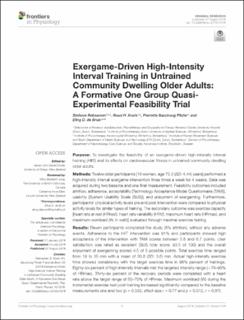Please use this identifier to cite or link to this item:
https://doi.org/10.21256/zhaw-26151Full metadata record
| DC Field | Value | Language |
|---|---|---|
| dc.contributor.author | Rebsamen, Stefanie | - |
| dc.contributor.author | Knols, Ruud H. | - |
| dc.contributor.author | Pfister, Pierrette Baschung | - |
| dc.contributor.author | de Bruin, Eling D. | - |
| dc.date.accessioned | 2022-11-18T15:08:00Z | - |
| dc.date.available | 2022-11-18T15:08:00Z | - |
| dc.date.issued | 2019 | - |
| dc.identifier.issn | 1664-042X | de_CH |
| dc.identifier.uri | https://digitalcollection.zhaw.ch/handle/11475/26151 | - |
| dc.description.abstract | Purpose: To investigate the feasibility of an exergame-driven high-intensity interval training (HIIT) and its effects on cardiovascular fitness in untrained community dwelling older adults. Methods: Twelve older participants [10 women, age 72.3 (SD: 4.44) years] performed a high-intensity interval exergame intervention three times a week for 4 weeks. Data was acquired during two baseline and one final measurement. Feasibility outcomes included attrition, adherence, acceptability [Technology Acceptance Model Questionnaire (TAM)], usability [System Usability Scale (SUS)], and enjoyment of exergaming. Furthermore, participants’ physical activity levels pre and post intervention were compared to physical activity levels for similar types of training. The secondary outcome was exercise capacity [heart rate at rest (HRrest), heart rate variability (HRV), maximum heart rate (HRmax), and maximum workload (W, in watt)] evaluated through maximal exercise testing. Results: Eleven participants completed the study (8% attrition), without any adverse events. Adherence to the HIIT intervention was 91% and participants showed high acceptance of the intervention with TAM scores between 5.8 and 6.7 points. User satisfaction was rated as excellent (SUS total score: 93.5 of 100) and the overall enjoyment of exergaming scored 4.5 of 5 possible points. Total exercise time ranged from 19 to 35 min with a mean of 30.8 (SD: 3.6) min. Actual high-intensity exercise time showed consistency with the target exercise time in 98% percent of trainings. Eighty-six percent of high-intensity intervals met the targeted intensity range (>70–90% of HRmax). Thirty-six percent of the recovery periods were completed with a heart rate above the target range of 50–70% of HRmax. Maximum workload (W) during the incremental exercise test post-training increased significantly compared to the baseline measurements one and two (p = 0.032, effect size r = 0.77 and p = 0.012, r = 0.87). Conclusion: High-intensity interval training through exergaming is feasible, safe, and shows high usability and acceptance in community dwelling older people. Exergame-driven HIIT had a significant effect on maximum power output on an incremental exercise test. A more extensive exergame intervention period, higher work to recovery ratios as well as a higher-intensity activity should be considered in future projects. | de_CH |
| dc.language.iso | en | de_CH |
| dc.publisher | Frontiers Research Foundation | de_CH |
| dc.relation.ispartof | Frontiers in Physiology | de_CH |
| dc.rights | https://creativecommons.org/licenses/by/4.0/ | de_CH |
| dc.subject | Aerobic exercise | de_CH |
| dc.subject | Exergaming | de_CH |
| dc.subject | Feasibility | de_CH |
| dc.subject | High-intensity interval training | de_CH |
| dc.subject | Older adult | de_CH |
| dc.subject | Virtual reality | de_CH |
| dc.subject.ddc | 613: Persönliche Gesundheit | de_CH |
| dc.title | Exergame-driven high-intensity interval training in untrained community dwelling older adults : a formative one group quasi-experimental feasibility trial | de_CH |
| dc.type | Beitrag in wissenschaftlicher Zeitschrift | de_CH |
| dcterms.type | Text | de_CH |
| zhaw.departement | Gesundheit | de_CH |
| zhaw.organisationalunit | Institut für Physiotherapie (IPT) | de_CH |
| dc.identifier.doi | 10.3389/fphys.2019.01019 | de_CH |
| dc.identifier.doi | 10.21256/zhaw-26151 | - |
| dc.identifier.pmid | 31440168 | de_CH |
| zhaw.funding.eu | No | de_CH |
| zhaw.issue | 1019 | de_CH |
| zhaw.originated.zhaw | Yes | de_CH |
| zhaw.publication.status | publishedVersion | de_CH |
| zhaw.volume | 10 | de_CH |
| zhaw.publication.review | Peer review (Publikation) | de_CH |
| zhaw.author.additional | No | de_CH |
| zhaw.display.portrait | Yes | de_CH |
| Appears in collections: | Publikationen Gesundheit | |
Files in This Item:
| File | Description | Size | Format | |
|---|---|---|---|---|
| 2019_Rebsamen-etal_Exergame-driven-high-intensity-interval-training-untrained-older-adults.pdf | 1.19 MB | Adobe PDF |  View/Open |
Show simple item record
Rebsamen, S., Knols, R. H., Pfister, P. B., & de Bruin, E. D. (2019). Exergame-driven high-intensity interval training in untrained community dwelling older adults : a formative one group quasi-experimental feasibility trial. Frontiers in Physiology, 10(1019). https://doi.org/10.3389/fphys.2019.01019
Rebsamen, S. et al. (2019) ‘Exergame-driven high-intensity interval training in untrained community dwelling older adults : a formative one group quasi-experimental feasibility trial’, Frontiers in Physiology, 10(1019). Available at: https://doi.org/10.3389/fphys.2019.01019.
S. Rebsamen, R. H. Knols, P. B. Pfister, and E. D. de Bruin, “Exergame-driven high-intensity interval training in untrained community dwelling older adults : a formative one group quasi-experimental feasibility trial,” Frontiers in Physiology, vol. 10, no. 1019, 2019, doi: 10.3389/fphys.2019.01019.
REBSAMEN, Stefanie, Ruud H. KNOLS, Pierrette Baschung PFISTER und Eling D. DE BRUIN, 2019. Exergame-driven high-intensity interval training in untrained community dwelling older adults : a formative one group quasi-experimental feasibility trial. Frontiers in Physiology. 2019. Bd. 10, Nr. 1019. DOI 10.3389/fphys.2019.01019
Rebsamen, Stefanie, Ruud H. Knols, Pierrette Baschung Pfister, and Eling D. de Bruin. 2019. “Exergame-Driven High-Intensity Interval Training in Untrained Community Dwelling Older Adults : A Formative One Group Quasi-Experimental Feasibility Trial.” Frontiers in Physiology 10 (1019). https://doi.org/10.3389/fphys.2019.01019.
Rebsamen, Stefanie, et al. “Exergame-Driven High-Intensity Interval Training in Untrained Community Dwelling Older Adults : A Formative One Group Quasi-Experimental Feasibility Trial.” Frontiers in Physiology, vol. 10, no. 1019, 2019, https://doi.org/10.3389/fphys.2019.01019.
Items in DSpace are protected by copyright, with all rights reserved, unless otherwise indicated.